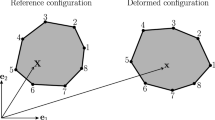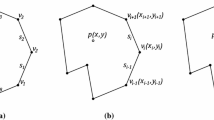Abstract
A novel polygonal finite element method (PFEM) based on partition of unity is proposed, termed the virtual node method (VNM). To test the performance of the present method, numerical examples are given for solid mechanics problems. With a polynomial form, the VNM achieves better results than those of traditional PFEMs, including the Wachspress method and the mean value method in standard patch tests. Compared with the standard triangular FEM, the VNM can achieve better accuracy. With the ability to construct shape functions on polygonal elements, the VNM provides greater flexibility in mesh generation. Therefore, several fracture problems are studied to demonstrate the potential implementation. With the advantage of the VNM, the convenient refinement and remeshing strategy are applied.
Similar content being viewed by others
References
Wachspress, E. L. A Rational Finite Element Basis, Academic Press, New York (1975)
Tabarraei, A. and Sukumar, N. Adaptive computations on conforming quadtree meshes. Finite Elements in Analysis and Design 41(7–8), 686–702 (2005)
Sukumar, N. and Malsch, E. A. Recent advances in the construction of polygonal finite element interpolants. Archives of Computational Methods in Engineering 13(1), 129–163 (2006)
Floater, M. S. Mean value coordinates. Computer Aided Geometric Design 20(1), 19–27 (2003)
Melenk, J. M. and Babuska, I. The partition of unity finite element method: basic theory and applications. Computer Methods in Applied Mechanics and Engineering 139(1–4), 289–314 (1996)
Rajendran, S. and Zhang, B. R. An “FE-meshfree” QUAD4 element based on partition of unity. Computer Methods in Applied Mechanics and Engineering 197(1–4), 128–147 (2007)
Liu, G. R. and Gu, Y. T. A point interpolation method for two dimensional solid. International Journal for Numerical Methods in Engineering 50(4), 937–951 (2001)
Zheng, C., Tang, X. H., Zhang, J. H., and Wu, S. C. A novel mesh-free poly-cell Galerkin method. Acta Mechanica Sinica 25(4), 517–527 (2009)
Zheng, C., Wu, S. C., Tang, X. H., and Zhang, J. H. A meshfree poly-cell Galerkin (MPG) approach for problems of elasticity and fracture. Computer Modelling in Engineering & Sciences 38(2), 149–178 (2008)
Strang, G. and Fix, G. An Analysis of the Finite Element Method, Prentice-Hall, Englewood Cliffs, N. J. (1973)
Zienkiewicz, O. C. and Taylor, R. L. The Finite Element Method, 5th Edition, Butterworth Heinemann, Oxford, U. K. (2000)
Mark, S. Shephard and Marcel, K. Georges. Automatic three-dimensional mesh generation by the finite octree technique. International Journal for Numerical Methods in Engineering 32(4), 709–749 (1991)
Timoshenko, S. P. and Goodier, J. N. Theory of Elasticity, 3rd Edition, McGraw, New York (1970)
Roark, R. J. and Young, W. C. Formulas for Stress and Strain, McGraw, New York (1975)
Belytschko, T. and Black, T. Elastic crack growth in finite elements with minimal remeshing. International Journal for Numerical Methods in Engineering 45(5), 601–620 (1999)
Moes, N., Dolbow, J., and Belyschko, T. A finite element method for crack growth without remeshing. International Journal for Numerical Method in Engineering 46(1), 131–150 (1999)
Aliabadi, M. H., Rooke, D. P., and Cartwright, D. J. Mixed-mode Bueckner weight functions using boundary element analysis. International Journal of Fracture 34(2), 131–147 (1987)
Bouchard, P. O., Bay, F., Chastel, Y., and Tovena, I. Crack propagation modeling using an advanced remeshing technique. Computer Methods in Applied Mechanics and Engineering 189(3), 723–742 (2000)
Author information
Authors and Affiliations
Corresponding author
Additional information
Communicated by Xing-ming GUO
Rights and permissions
About this article
Cite this article
Tang, Xh., Wu, Sc., Zheng, C. et al. A novel virtual node method for polygonal elements. Appl. Math. Mech.-Engl. Ed. 30, 1233–1246 (2009). https://doi.org/10.1007/s10483-009-1003-3
Received:
Revised:
Published:
Issue Date:
DOI: https://doi.org/10.1007/s10483-009-1003-3




